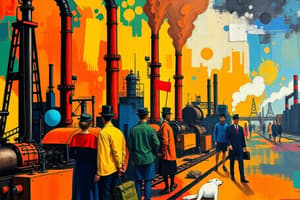Podcast
Questions and Answers
Die Entwicklung der ______ führte zur Entstehung einer industriellen Gesellschaft.
Die Entwicklung der ______ führte zur Entstehung einer industriellen Gesellschaft.
Fabriken
Die Erfindung der ______ ermöglichte einen tiefgreifenden Wandel in der Arbeitsweise der Menschen.
Die Erfindung der ______ ermöglichte einen tiefgreifenden Wandel in der Arbeitsweise der Menschen.
Dampfmaschine
George Stephenson erfand die erste ______ im Jahr 1815.
George Stephenson erfand die erste ______ im Jahr 1815.
Dampflokomotive
Die ersten dampfbetriebenen Maschinen wurden in der ______ eingesetzt.
Die ersten dampfbetriebenen Maschinen wurden in der ______ eingesetzt.
Vor der Industrialisierung war die Kommunikation stark abhängig von ______ und Postdiensten.
Vor der Industrialisierung war die Kommunikation stark abhängig von ______ und Postdiensten.
Die Bevölkerung wuchs stark, was zu einem Bedarf an mehr ______ führte.
Die Bevölkerung wuchs stark, was zu einem Bedarf an mehr ______ führte.
Um mehr Nahrungsmittel zu produzieren, waren Fortschritte in der ______ nötig.
Um mehr Nahrungsmittel zu produzieren, waren Fortschritte in der ______ nötig.
Die Einführung von ______ half, den Boden fruchtbarer zu machen.
Die Einführung von ______ half, den Boden fruchtbarer zu machen.
Die ______ wurde eingeführt, um die Effizienz in der Landwirtschaft zu steigern.
Die ______ wurde eingeführt, um die Effizienz in der Landwirtschaft zu steigern.
Zu Beginn des 19. Jahrhunderts wurden landwirtschaftliche ______ verbessert.
Zu Beginn des 19. Jahrhunderts wurden landwirtschaftliche ______ verbessert.
Die Wohnungen für Arbeiter waren oft ______ und hatten hohe Mieten.
Die Wohnungen für Arbeiter waren oft ______ und hatten hohe Mieten.
Die bürgerliche Familie bestand hauptsächlich aus ______ und Kindern.
Die bürgerliche Familie bestand hauptsächlich aus ______ und Kindern.
Die Hauptaufgaben von Frauen waren die Kindererziehung und die ______.
Die Hauptaufgaben von Frauen waren die Kindererziehung und die ______.
Frauen durften anfangs keine ______ besuchen und hatten eingeschränkten Zugang zu Bildungseinrichtungen.
Frauen durften anfangs keine ______ besuchen und hatten eingeschränkten Zugang zu Bildungseinrichtungen.
Die Suffragetten forderten unter anderem das ______ für Frauen.
Die Suffragetten forderten unter anderem das ______ für Frauen.
Die ______ erlaubte die Massenproduktion von Waren.
Die ______ erlaubte die Massenproduktion von Waren.
Durch die Erfindung der ______ wurde die Produktion beschleunigt.
Durch die Erfindung der ______ wurde die Produktion beschleunigt.
Die ______ benötigten Arbeitskräfte, was viele Menschen aus ländlichen Gebieten anzog.
Die ______ benötigten Arbeitskräfte, was viele Menschen aus ländlichen Gebieten anzog.
Die Phrase '______ macht frei' wurde ein bekanntes Motto dieser Zeit.
Die Phrase '______ macht frei' wurde ein bekanntes Motto dieser Zeit.
Die Arbeitsbedingungen in den Fabriken waren oft ______.
Die Arbeitsbedingungen in den Fabriken waren oft ______.
Arbeiter erhielten keine ______ und mussten lange Stunden arbeiten.
Arbeiter erhielten keine ______ und mussten lange Stunden arbeiten.
Die______ umfasste große Geschäftsinhaber, Angestellte und kleine Unternehmer.
Die______ umfasste große Geschäftsinhaber, Angestellte und kleine Unternehmer.
Viele ______ wurden aufgrund ihrer Größe und Schnelligkeit in den Fabriken eingesetzt.
Viele ______ wurden aufgrund ihrer Größe und Schnelligkeit in den Fabriken eingesetzt.
Robert Owen war der Begründer des ______.
Robert Owen war der Begründer des ______.
Pierre Proudhon bezeichnete Eigentum als ______, wenn es nicht durch Arbeit erworben wurde.
Pierre Proudhon bezeichnete Eigentum als ______, wenn es nicht durch Arbeit erworben wurde.
Der Marxismus versteht die Geschichte als Geschichte des ______.
Der Marxismus versteht die Geschichte als Geschichte des ______.
Das Ziel des Marxismus ist eine ______ Gesellschaft ohne Privateigentum.
Das Ziel des Marxismus ist eine ______ Gesellschaft ohne Privateigentum.
Gewerkschaften kämpfen um bessere ______.
Gewerkschaften kämpfen um bessere ______.
Eines der Kampfmittel der Arbeiter war der ______.
Eines der Kampfmittel der Arbeiter war der ______.
Der Unternehmer wünscht sich Treue, Disziplin und ______ von den Arbeitern.
Der Unternehmer wünscht sich Treue, Disziplin und ______ von den Arbeitern.
Die ersten Priester, die sich mit der Sozialen Frage beschäftigten, traten im ______ Jh. auf.
Die ersten Priester, die sich mit der Sozialen Frage beschäftigten, traten im ______ Jh. auf.
Flashcards
Industrial Revolution
Industrial Revolution
A major shift from agrarian to industrial society, marked by factories and machinery.
Steam Engine
Steam Engine
A crucial invention that powered early factories and machinery.
Textile Industry
Textile Industry
Key industry of the early Industrial Revolution, involving spinning and weaving.
Railways
Railways
Signup and view all the flashcards
Communication Advancements
Communication Advancements
Signup and view all the flashcards
Agricultural Innovations
Agricultural Innovations
Signup and view all the flashcards
Crop Rotation
Crop Rotation
Signup and view all the flashcards
Fertilizers
Fertilizers
Signup and view all the flashcards
Steam Engine's Role
Steam Engine's Role
Signup and view all the flashcards
Improved Farm Equipment (19th Century)
Improved Farm Equipment (19th Century)
Signup and view all the flashcards
Worker Housing
Worker Housing
Signup and view all the flashcards
Bourgeois Family
Bourgeois Family
Signup and view all the flashcards
Woman's Roles
Woman's Roles
Signup and view all the flashcards
Women's Suffrage
Women's Suffrage
Signup and view all the flashcards
Women's Education
Women's Education
Signup and view all the flashcards
Mass production
Mass production
Signup and view all the flashcards
Working class
Working class
Signup and view all the flashcards
Bourgeoisie
Bourgeoisie
Signup and view all the flashcards
Factory work demands
Factory work demands
Signup and view all the flashcards
Child labor
Child labor
Signup and view all the flashcards
Industrial society
Industrial society
Signup and view all the flashcards
Rise of Retail
Rise of Retail
Signup and view all the flashcards
Urban Shift
Urban Shift
Signup and view all the flashcards
Socialism
Socialism
Signup and view all the flashcards
Marxism
Marxism
Signup and view all the flashcards
Gewerkschaften
Gewerkschaften
Signup and view all the flashcards
Streik
Streik
Signup and view all the flashcards
Bourgeoisie
Bourgeoisie
Signup and view all the flashcards
Proletariat
Proletariat
Signup and view all the flashcards
Sozialleistungen
Sozialleistungen
Signup and view all the flashcards
Kolping
Kolping
Signup and view all the flashcards



